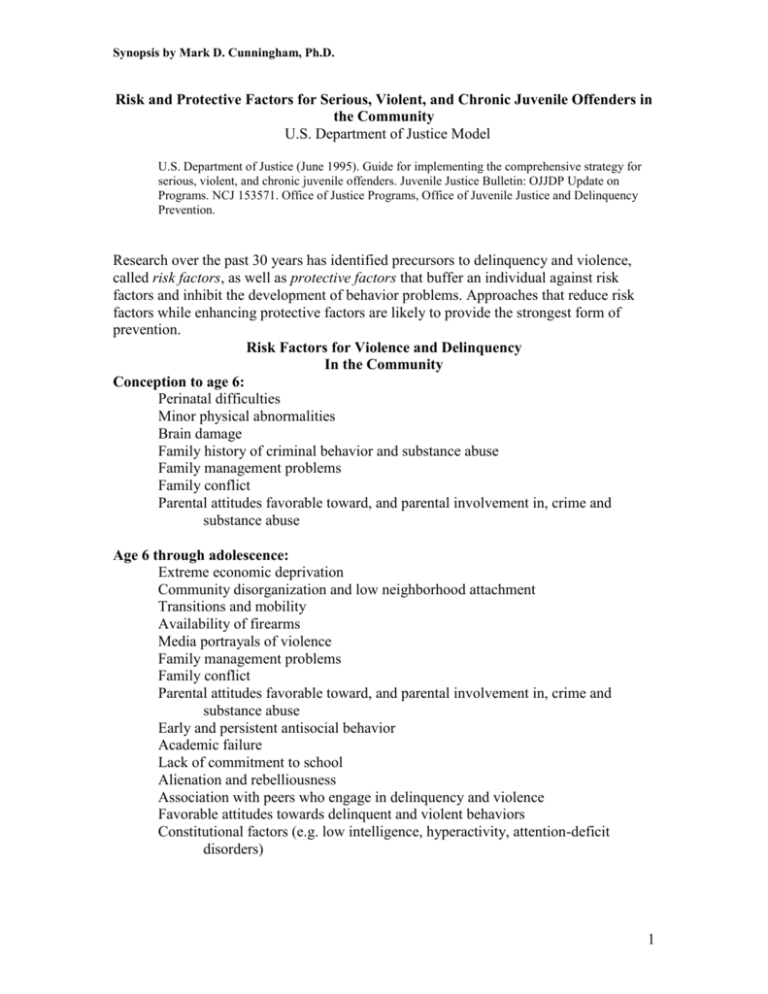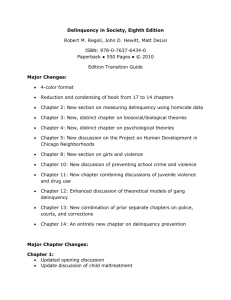Risk and Protective Factors for Serious, Violent, and Chronic
advertisement

Synopsis by Mark D. Cunningham, Ph.D. Risk and Protective Factors for Serious, Violent, and Chronic Juvenile Offenders in the Community U.S. Department of Justice Model U.S. Department of Justice (June 1995). Guide for implementing the comprehensive strategy for serious, violent, and chronic juvenile offenders. Juvenile Justice Bulletin: OJJDP Update on Programs. NCJ 153571. Office of Justice Programs, Office of Juvenile Justice and Delinquency Prevention. Research over the past 30 years has identified precursors to delinquency and violence, called risk factors, as well as protective factors that buffer an individual against risk factors and inhibit the development of behavior problems. Approaches that reduce risk factors while enhancing protective factors are likely to provide the strongest form of prevention. Risk Factors for Violence and Delinquency In the Community Conception to age 6: Perinatal difficulties Minor physical abnormalities Brain damage Family history of criminal behavior and substance abuse Family management problems Family conflict Parental attitudes favorable toward, and parental involvement in, crime and substance abuse Age 6 through adolescence: Extreme economic deprivation Community disorganization and low neighborhood attachment Transitions and mobility Availability of firearms Media portrayals of violence Family management problems Family conflict Parental attitudes favorable toward, and parental involvement in, crime and substance abuse Early and persistent antisocial behavior Academic failure Lack of commitment to school Alienation and rebelliousness Association with peers who engage in delinquency and violence Favorable attitudes towards delinquent and violent behaviors Constitutional factors (e.g. low intelligence, hyperactivity, attention-deficit disorders) 1 Synopsis by Mark D. Cunningham, Ph.D. Protective Factors that Inhibit Violence and Delinquency in the Community U.S. Department of Justice (June 1995) Individual characteristics: Female gender Intelligence Positive social orientation Resilient temperament Social bonding to positive role models: Family members Teachers Coaches Youth leaders Friends Healthy beliefs and clear standards for behavior, including those that promote nonviolence and abstinence from drugs. Effective early interventions. U.S. Department of Justice (April 2000) Predictors of Youth Violence in the Community Hawkins, J.D., Herrenkohl, T.I., Farrington, D.P., Brewer, D., Catalano, R.F., Harachi, T.W., & Cothern, L. (April 2000). Predictors of youth violence. Juvenile Justice Bulletin. U.S. Department of Justice, Office of Justice Programs, Office of Juvenile Justice and Delinquency Prevention. Office of Juvenile Justice and Delinquency Prevention coordinated 22 researchers brought together for 2 years Analyzed current research on risk and protective factors in the development of serious youth violence Synthesis of 66 studies, plus research reports, plus longitudinal data Identified individual, family, school, peer-related, and community/neighborhood risk factors Cumulative impact: the larger the number of risk factors the youth was exposed to, the greater the probability of violent behavior in the community. 2 Synopsis by Mark D. Cunningham, Ph.D. Factors associated with serious youth violence (odds ratios in parenthesis): Individual factors Hyperactivity, concentration problems, restlessness, and risk taking (x 2 - 5) Aggressiveness (x .5 - 6) Early initiation of violent behavior (x 6) Involvement in other forms of antisocial behavior Beliefs and attitudes favorable to deviant or antisocial behavior. Family factors Parental criminality (x 0 - 3.8) Child maltreatment Poor family management practices (x 2) Low levels of parental involvement Poor family bonding and family conflict Residential mobility (+) Parental attitudes favorable to substance abuse and violence (x 2) Parent-child separation School factors Academic failure Low bonding to school Truancy and dropping out of school Frequent school transitions High delinquency rate schools Peer-related factors Delinquent siblings Delinquent peers Gang membership (x 3-4) Community and neighborhood factors Poverty (x 2) Community disorganization (crime, drug-selling, gangs, poor housing) Availability of drugs and firearms Neighborhood adults involved in crime Exposure to violence and racial prejudice Situational factors 3 Synopsis by Mark D. Cunningham, Ph.D. Risks Associated with Father Absence 57% of black children living with mother only are in poverty, compared with 15% living with married parents. U.S. Bureau of Census (1993). Poverty in the United States, 1992. Series P-60, no. 185. U.S. Government Printing Office, Washington, D.C. The low supervision of adolescents frequently found in father-absent homes was more the cause of delinquency than poverty. Sampson, R.J. & Laub, J.H. (1994). Urban poverty and the family context of delinquency: A new look at structure and process in a classic study. Child Development, 65, 523-540. More likely to commit a school crime. Jenkins, P.H. (1995). School delinquency and school commitment. Sociology of Education, 68, 221-239 The likelihood that a young male will engage in criminal activity doubles if he is raised without a father and triples if he lives in a neighborhood with a high concentration of single-parent families. Hill, M.A. & O’Neil, J. (1993). Underclass behaviors in the United States: Measurement and Analysis of Determinants. City University of New York, Baruch College. 70% of the juveniles in state reform institutions grew up in single- or no-parent situations. Beck, A. Kline, S., & Greenfield, L. (September, 1988). Survey of youth in custody, 1987. Bureau of Justice Statistics. 72% of adolescent murderers grew up without fathers. Cornell, D. et. al. (1987). Characteristics of adolescents charged with homicide. Behavioral Sciences and the Law, 5, 11-23. Fatherless children are at a dramatically greater risk of drug and alcohol abuse, mental illness, suicide, poor educational performance, teen pregnancy and criminality. U.S. Department of Health and Human Services (1993), National Center for Health Statistics, Survey of Child Health, Washington, D.C. 4 Synopsis by Mark D. Cunningham, Ph.D. Risks Associated with having a Teenage Mother More likely to be low birth weight (x .5) Suffer poorer health in childhood but receive only half the level of medical care Much less likely to grow up in a family with a father Quality of the home is lower in emotional support and cognitive stimulation More likely to run away from home (x 2.5) Far more likely to be physically abused, abandoned, or neglected (x 2 compared to 20-21 year old mothers) 5% end up in foster care Do much worse in school. Less likely to be rated “excellent” by teachers (x 2-3). More likely to repeat a grade (x .5) More likely to drop out of school (x 2 – half related to teen mother) At age 24 approximately 30% are neither in school nor working (x .71 – half related to teen mother) Sons of teen mothers are more likely to land in prison (x 2.7 – 19% attributed to teen mother alone) Adolescent childbearing alone cost $1 billion annually in prison costs for their sons. Total annual social cost to taxpayers is $29 billion. Kids having kids: A Robin Hood Foundation special report on the costs of adolescent childbearing. R.A. Maynard (Editor). 5 Synopsis by Mark D. Cunningham, Ph.D. Outcomes of Maltreated Children Widom Study 908 children court identified as abused/neglected before age 11 in 1967-1971; and 667 matched controls 676 abused/neglected and 520 controls interviewed in late 1990’s Criminal arrest Arrest for violent crime Abused/Neglected 56.5% 21.0% Controls 42.5% 15.6% Widom, C.S. (January, 2000). Childhood victimization: Early Adversity, later psychopathology. National Institute of Justice Journal. Rochester Youth Development Study 1,000 7th and 8th graders in Rochester, New York in 1988 14% had maltreatment record Youths and primary caretakers interviewed every 6 months regarding violence Criminal violence Abused/Neglected 69% Controls 56% Kelley, B.T., Thornberry, T.P., & Smith, C.A. (August, 1997). In the wake of childhood maltreatment. Juvenile Justice Bulletin. Office of Juvenile Justice and Delinquency Prevention, U.S. Department of Justice Additional findings of the Rochester Youth Development Study regarding violence in home: Three types of family violence exposure studied Spouse abuse Abuse of children Climate of violence and hostility Rates of serious youth violence: If no family violence If one type of violence If two types of violence If three types of violence = = = = 38% 60% 73% 78% Thornberry, T.P. (December, 1994). Violent families and youth violence. Fact sheet #21. National Criminal Justice Resources and Statistics. U.S. Department of Justice. 6 Synopsis by Mark D. Cunningham, Ph.D. Implications of Youthfulness Brain development continues to age 25, particularly in the frontal lobes. judgment empathy impulse control responsibility delay of gratification appreciation of consequences Characteristics of adolescence confirmed by research*: …adolescents tend to be less mature, more impulsive, and less capable of controlling their conduct and thinking in terms of long-range consequences. Adolescence is a stage of human development in which one's character and moral judgment are incomplete and still undergoing formation. Factors that delay maturity: Low IQ Psychological disorder Developmental trauma Substance abuse Peer isolation and rejection Corruptive community or family *Brief of the American Society for Adolescent Psychiatry and the American Orthopsychiatric Association filed as an amici curiae in Thompson v Oklahoma (1986) in the U.S. Supreme Court. 7










